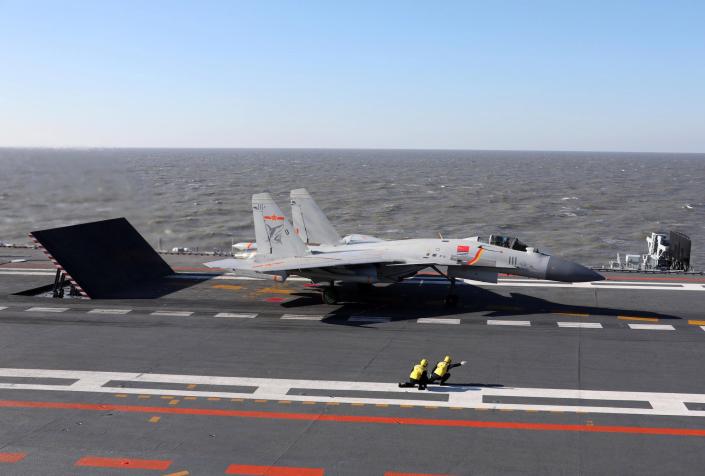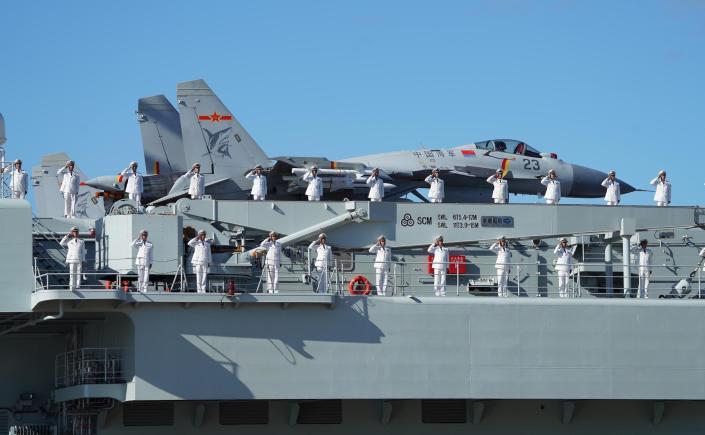
-
China’s fleet of aircraft carriers has grown quickly, expanding from one to three in a decade.
-
To use that fleet effectively, China’s navy also has to train pilots to operate carrier aircraft.
-
To find enough pilots for what could be six carriers, China’s navy is expanding its recruiting pool.
Eager to find pilots for its growing fleet of aircraft carriers, China is turning to a new source of manpower — in this case, woman power.
For the first time, the People’s Liberation Army Navy, known as the PLAN, is recruiting women as well as recent college graduates to become pilots in its new carrier aviation arm. While US naval aviation arrived in 1910, it wasn’t until 1990 that the US Navy had its first woman fighter pilot.
“Starting in 2023, the Navy will select carrier-based aircraft pilots from fresh graduates from local ordinary colleges and universities,” according to a Chinese navy brochure. “We welcome young men and women who love national defense, are committed to the sea and air, and are well-rounded to participate in the selection process, so that they can dedicate their youth to building a world-class navy and contribute to the great rejuvenation of the Chinese nation!”
The brochure lists a variety of prerequisites, some of which are common to military aviation and some which are unique to Communist China.

Candidates must be no older than 24 and must have majored in science and technology. They must be no taller than 6 feet and be unmarried. Naturally, they must “love the [Communist] Party, love the motherland, love the people and love socialism” and have a “clean political history.”
This marks the first time that the PLAN is accepting naval aviation candidates who didn’t attend military colleges, according to state-sponsored news site Global Times. A source told the Global Times that the navy believes that four years of college creates a solid foundation for prospective naval aviators.
In recent years, the world has focused on China’s emerging aircraft carrier fleet, which has grown from just one dilapidated ex-Soviet carrier a decade ago to three carriers now, including two built in Chinese shipyards. Some experts believe that China may eventually build six or more carriers, which could challenge the US Navy, especially in the South China Sea and other waters close to China.
Yet it takes more than ships to build an effective carrier fleet. When it comes to naval aviation, America dwarfs any other nation simply because the US Navy has an enormous pool of pilots as well as a solid training system.
Even though the US Navy and Air Force currently face pilot shortages — as do commercial airlines — the Navy still has around 7,000 pilots on its rolls.

China is more or less starting from scratch, which means bulking up to a sufficient number of carrier-qualified fliers as well as creating the training pipeline necessary to maintain a steady flow of new pilots. Tapping China’s female population is one solution, even though China has one of the lowest numbers of female pilots in the world.
Indeed, China’s dangerously low birth rate has incentivized the Chinese military as a whole to recruit more women.
In addition to pilots, China also needs high-performance carrier jets. The US Navy has been designing carrier-based planes since the 1920s, including modern jets such as the F-14, F/A-18, and now the F-35.
While China has a large and advanced aviation industry, it doesn’t have the depth of experience or expertise that other, more mature sailors have. In fact, the Chinese navy ended up copying a Russian carrier jet without permission to give its carrier program a boost.
That Chinese knockoff, the J-15, became notorious for crashing, much to the glee of Russian media, but the Chinese naval aviation fleet continues to grow, adding more advanced fighter jets and other carrier-capable aircraft.
US naval aviation had its growing pains, too. One reason the US Navy is proficient at carrier operations is that it has been launching airplanes from floating airfields for a century. China may need time to catch up, but there is no reason it can’t do the same.
Michael Peck is a defense writer whose work has appeared in Forbes, Defense News, Foreign Policy magazine, and other publications. He holds a master’s in political science. Follow him on Twitter and LinkedIn.
Read the original article on Business Insider